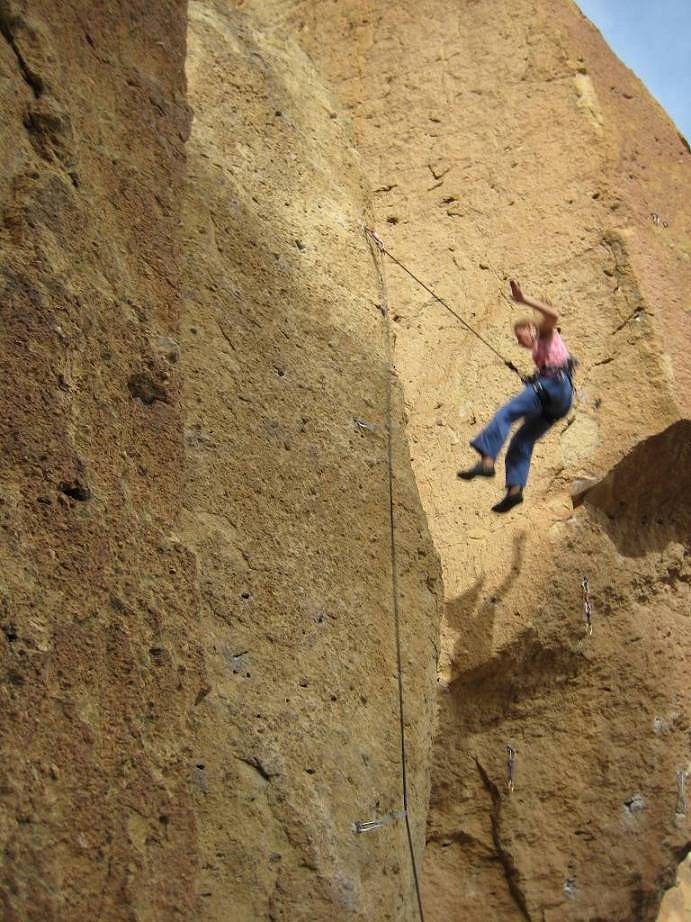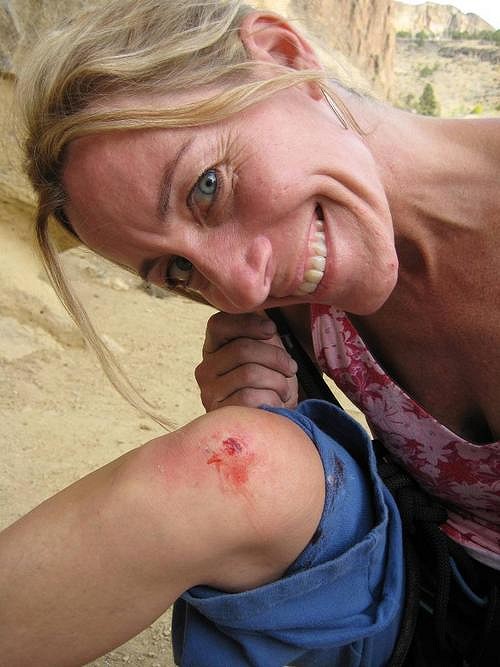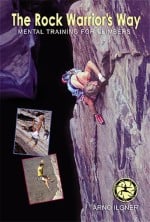It's important to know what learning is and what it isn't. What Steve did is an example of what learning is NOT. Most of us deal with fears by looking for tricks or techniques that will take us around our fears instead of facing them directly. In order to learn we must process ourselves through a situation, not just get to the end of it. Let's see how this plays out in one particular aspect of climbing—falling.

In order to learn how to fall you need to develop the ability to take a fall and still remain relaxed in your body. By taking your body through experiences you learn. Your body creates schemas to embody knowledge. If you take a long fall first and tense up, then you learn to tense up. This is exactly the opposite of what you want to learn in falling. Instead, you need to learn in smaller increments. You know you've learned something when you're comfortable doing it. You know you're comfortable falling when your body responds in four specific ways. You need to be able to fall and:
- Breathe...continuously throughout
- Eyes...looking down, in the direction of the developing situation
- Relax...your body, use just the amount of energy needed for the task
- Posture ...with shoulders rolled back and down, and arms out, knees bent and shoulder width apart
This is universal for learning any skill. You need to experience all four of these states while doing the skill, not when it is over. Steve did not experience these states during the fall, but rather bypassed the learning process due to a few misalignments.
Misalignments
Learning involves acquiring two types of knowledge, intellectual and experiential. As an example of intellectual knowledge, imagine a climber facing a 15-foot fall on a slightly overhanging wall. His mind tells him that he shouldn't be afraid because the fall is clean. But, no matter how much he intellectualizes about why he shouldn't be afraid, he still has difficulty committing to challenging climbing when the risk of a fall is great. He doesn't fully trust the intellectual knowledge and can't actively engage the fall. Experiential knowledge, on the other hand, is complete knowledge that your whole body possesses. Experiential knowledge derives directly from situations you've gone through; that you have actually engaged many times. You aren't afraid of taking a 15-foot fall on a slightly overhanging wall because you've taken many such falls.
The learning process consists of constantly converting intellectual knowledge into experiential knowledge by engaging your body. By engaging stressful situations you process your body through them and expand your mind's perception of what it can deal with.
Limitations of the Mind
There are two things that will impact the quality of your learning. First, if you are too mental in your approach, you'll focus on the end result instead of the process. This is because your mind doesn't like stress. It is focused on the end goal because that is where the mind will be comfortable again. Second, if you bite off too big of a learning chunk you will react in the way Steve did and not learn. Actually, your body will learn how to tense up and then you have to unlearn that. So, an important element of learning needs to be biting off just the right amount of discomfort and unknown, but not too much.
When you practice falling, make sure your goal isn't to overcome fear of falling but rather to develop more ability to be comfortable when falling. These may sound the same but they aren't. Overcoming fear of falling is an end result. You practice falling so you don't have to do it anymore. Developing more ability to be comfortable falling involves a process that you can continually apply each time you go climbing. You make it part of your routine.
Realize that fears will occur in areas where you lose familiarity. Identify all the foundational aspects of climbing—falling being one of them— and incorporate some practice each day you go climbing.
Access to Complete Learning
Since your mind will limit you to intellectual learning, you need to find a different process for accessing a more complete kind of learning. Gaining that access point involves two things: First, let go of your mind's desire for comfort. Second, find little ways to engage the stress. This two-fold process will help you stay present for the task and see value in the stress. Your mind will want to bypass the stress by making you do things such as letting go quickly when you decide to take a fall. You need to look curiously for where the stress comes up and send your attention there. Many climbers say that the actual falling isn't the scary part, “it's that letting go part that is scary.” If this is where stress arises in you, then find ways to be present during that transition rather than getting it over with. It's important to remind yourself that the goal isn't to overcome fear of falling; the goal is to develop more ability to be present in the stressful falling situation.

Your comfort zone is made up of stressful situations from the past that you have “organized” by engaging those situations until they weren't stressful anymore. To expand your comfort zone, first intellectualize the next challenge for learning. Then engage it with your body, in small, manageable increments, until you can complete your practice exercise with the four indications of comfort. When you've done that you've embodied the knowledge that was previously simply an intellectual understanding.
Practice Tip: Falling
We tend to practice falling, or anything stressful, to get it over with. This will not only delay our learning of the skill but will also cause us to learn it incorrectly. Our body will learn to tense up. Learning how to fall means we learn to remain relaxed while falling. Here is a learning-based approach to practicing falling.
1. Small increments: Begin on toprope
First, simply hang on the rope and swing around.
Second, take toprope falls
Third, take lead falls
2. Gauge for learning: Comfort
First, stay at the same increment until you are comfortable
Second, you know you are comfortable when...
B: You're breathing throughout the fall
E: You're looking down during the fall
R: You're relaxed throughout the fall
P: You're arms are out; not grabbing the rope
3. Belaying: Giving a cushioned catch
First, do not progress to lead falls until your belayer learns how to give you a cushioned catch during toprope falls.
Second, a cushioned catch is: the belayer gives in to the pull when you fall. Your belayer should end up about five feet off the ground when your fall is ended. If he isn't, then he will need to push off as the rope becomes taut. This will be a learning process for your belayer.
You can read more Arno at UKClimbing.com. Motivation Justification HERE
Feeling Safe is Dangerous HERE
Learn to Expect; Expect to Learn HERE
Why Are You Taking a Risk? HERE
No Expectations HERE
Arno Ilgner is founder and president of Desiderata Institute, a multi-faceted medium which includes the Warrior's Way Course — designed to specifically help climbers overcome mental obstacles that are inhibiting their performance. Since 1973 Arno has developed and perfected specific physical and mental training methods, which are not only unique but highly effective as well. These methods are taught in the Warrior's Way Course. Through the Institute he also guides clients on mountains and cliffs in the Southeast USA. He served as a platoon leader in the US Army with tours of duty in Korea and Colorado has been a member of the American Alpine Club since 1983. He co-authored the first guide book to Fremont Canyon in Wyoming, and has published articles in Rock & Ice, Boulderdash! and Climbing magazines. Arno's interests range from mountaineering, to sport climbing, long free traditional routes, to big wall climbing.

His book The Rock Warrior's Way: Mental Training for Climbers is available from his websiteThe Warrior's Way and from Amazon

Comments